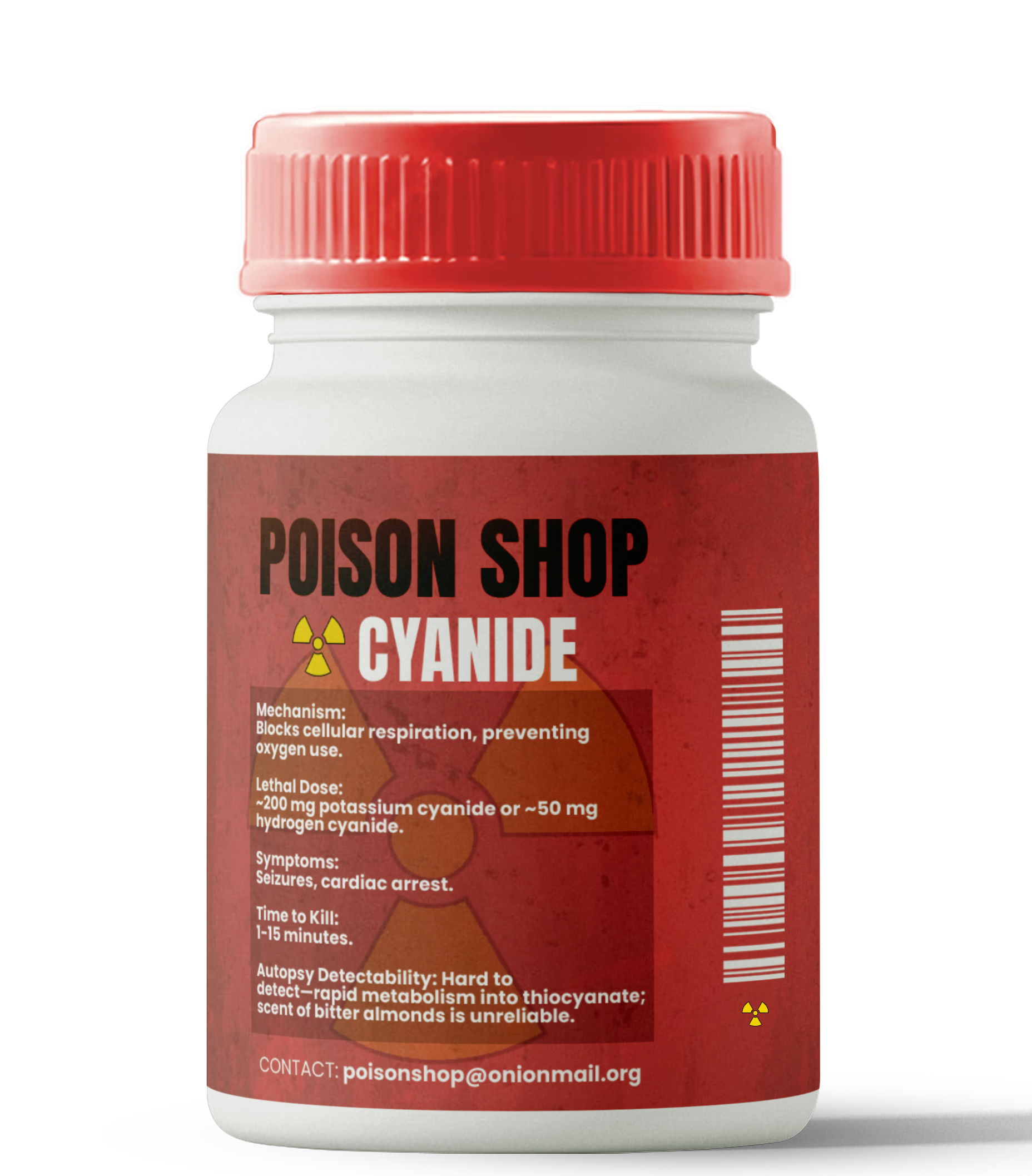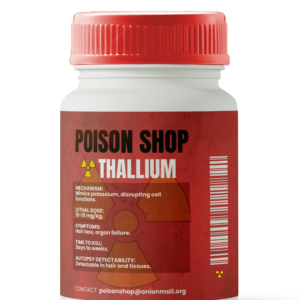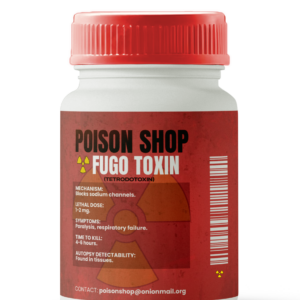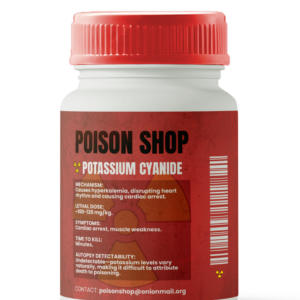Description
Cyanide: A Comprehensive Product Overview
Name: Cyanide
Chemical Formula: CN⁻ (Cyanide ion), often encountered as hydrogen cyanide (HCN) or potassium cyanide (KCN)
Origin: Cyanide is a naturally occurring compound found in certain plants, animals, and bacteria, but it is also produced synthetically for various industrial uses. Historically, cyanide has been infamous as a poison due to its rapid lethality and use in both historical assassinations and suicides.
Origin and Background
Cyanide compounds have been recognized for their toxicity for centuries. Some plants, such as cassava, lima beans, and almonds, contain cyanogenic glycosides, which release cyanide when metabolized. Cyanide gained notorious attention during World War II, when it was used as a method of execution in gas chambers, and has since appeared in various high-profile assassinations and suicide cases.
Industrially, cyanide is utilized in metal mining (gold extraction), electroplating, and chemical synthesis, as well as the production of plastics and pesticides. Despite its deadly reputation, cyanide remains a key player in modern industries.
Mechanism of Action
Cyanide works by disrupting cellular respiration. Specifically, cyanide binds to the enzyme cytochrome c oxidase within the mitochondria, which is essential for oxygen utilization during the production of adenosine triphosphate (ATP), the energy currency of the cell. By inhibiting this enzyme, cyanide prevents cells from using oxygen, effectively suffocating them at the cellular level.
Without functional cellular respiration, critical organs like the heart and brain are deprived of oxygen, leading to rapid onset of symptoms and death if not treated immediately.
Lethal Dose
The lethal dose of cyanide varies depending on the form and route of exposure. However, common values include:
- Inhalation (Hydrogen Cyanide gas – HCN): As little as 50 to 60 mg of hydrogen cyanide can be fatal for an adult.
- Ingestion (Potassium or Sodium Cyanide – KCN/NaCN): A dose of 200-300 mg can result in death.
Symptoms of Poisoning
Cyanide poisoning typically causes symptoms to appear within minutes due to its rapid mechanism of action. Key symptoms include:
- Sudden collapse
- Difficulty breathing (dyspnea)
- Chest pain
- Nausea and vomiting
- Dizziness and confusion
- Seizures
- Loss of consciousness
- Cardiac arrest
The skin may take on a cherry-red appearance, as oxygen remains unused in the blood despite being present. This symptom is sometimes described as “cyanosis” but with a paradoxical red hue instead of the blue tone typically associated with oxygen deprivation.
Time to Kill
Cyanide is one of the fastest-acting poisons known. Depending on the dose and form of cyanide, death can occur within:
- Inhalation (Hydrogen Cyanide gas – HCN): 1 to 2 minutes after exposure to a lethal dose.
- Ingestion (Potassium or Sodium Cyanide – KCN/NaCN): Death can occur within 15-30 minutes after ingestion of a lethal dose.
The extreme rapidity of cyanide’s effects makes it one of the most feared and potent poisons.
Detection in Autopsy
Yes, cyanide poisoning can be detected during an autopsy, though detection must be done quickly as cyanide breaks down rapidly in the body. During an autopsy, forensic pathologists may look for bright red venous blood (indicative of the oxygen retention caused by cyanide) and other tell-tale signs like the scent of almonds (although only a percentage of people can detect this smell).
Toxicological analysis can confirm cyanide poisoning by detecting the cyanide ion in the blood or tissues. Specialized tests, including gas chromatography-mass spectrometry (GC-MS), can identify and quantify cyanide levels in biological samples.
Conclusion
Cyanide remains one of the most lethal toxins known, capable of killing within minutes by halting the body’s ability to use oxygen at the cellular level. Its lethal dose is minuscule, and without immediate treatment, death is almost certain. However, despite its infamy as a poison, cyanide has various industrial applications. Whether in history or modern use, cyanide’s deadly potential and rapid action make it a potent toxin.






Alfred N. –
“Cyanide does the job, but the violent reaction it causes can be distressing for anyone present.”
Freya –
“Effective, but the method is brutal. The pain and convulsions make it a terrible choice.” But to be honest,that’s what the murderer of my father deserves. I HOPE HE STILL GET KILLED IN HELL.
Ruebelt-Germany –
1. “Cyanide is incredibly potent, and it
works quickly. The downside is the
excruciating pain and the difficulty in
acquiring it.”
Aurélie –
The potency of cyanide is unmatched, but the suffering endured is horrendous
Genevieve-France –
I still believe I did what needed to be done ,for the greater good. It was either Them or me. Quick results, but the side effects are horrific, leading to a terrifying and painful end
Anneliese –
To defeat evil sometimes ,you need to practice it. I don’t really feel sorry ,knowing that I freed many girls from being exploited sexually and to sell drugs.
Highly effective but extremely painful and traumatic. The death process is far from peaceful.
Noah Olaf-Switzerland –
“I used cyanide for its effectiveness.
However, the symptoms were severe,including convulsions and difficulty breathing.”